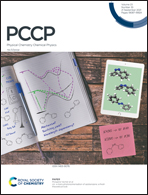Understanding the close encounter of heme proteins with carboxylated multiwalled carbon nanotubes: a case study of contradictory stability trend for hemoglobin and myoglobin†
Abstract
Carbon nanotubes (CNTs) are one of the unique and promising nanomaterials that possess plenty of applications, such as biosensors, advanced drug delivery systems and biotechnology. CNTs bind rapidly with proteins, which result in the formation of a protein coating layer known as a “protein corona” around the surface of the nanomaterial. This hinders their applications as a drug carrier and influences the properties of biological macromolecules. The present work focuses on studying the thermal stability and molecular level interactions of two heme proteins, hemoglobin (Hb) and myoglobin (Mb), in the presence of carboxylated functionalized multi-walled CNTs (CA-MWCNTs). Through the current study, the following steps have been taken to distinguish the biocompatibility of the hydrophilic surface CA-MWCNTs for heme proteins via a series of spectroscopic techniques and differential scanning calorimetry (DSC). UV-Visible and steady-state fluorescence spectroscopy were used to reveal changes in the aromatic amino acid residues of heme proteins upon the addition of CA-MWCNTs. Circular dichroism spectroscopy (CD) shows the alteration in the native structure of proteins in the presence of the nanomaterial. A tremendous increase in the size of the protein CA-MWCNTs system is observed in dynamic light scattering (DLS), which clearly manifests the protein corona formation. Unexpectedly, both proteins interact differently with CA-MWCNTs, which is observed in CD spectroscopy and DSC. In the presence of CA-MWCNTs, an increase in the transition temperature (Tm) was observed for Hb, while the Tm value decreases for Mb. Different interactions with proteins at the molecular scale may be the reason for this unexpected behavior. Henceforth, the present results can help in the design of the next-generation drug carrier nanomaterials with the idea of the heme protein corona formation prior to development.



 Please wait while we load your content...
Please wait while we load your content...